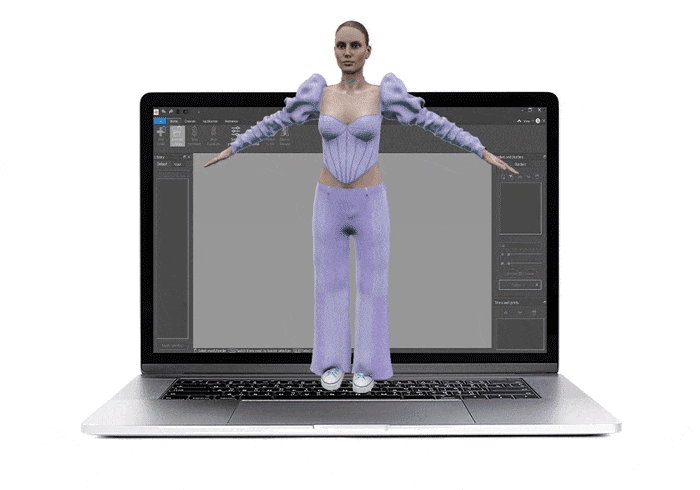Summary
- The textile designer is a professional responsible for various activities in fashion production, including creating prints, and textures.
- They play a crucial role in selecting the right materials for each use, contributing to the creation of incredible fashion pieces.
- Explore the Audaces360 multi-solution to efficiently manage every stage of your collection. Get a free trial now!
The textile designer holds a fundamental position in the fashion industry, contributing to various aspects of the creative process.
Their responsibilities range from crafting prints and patterns to fabric development, trend analysis, and collaboration with fashion designers.
Additionally, they are actively involved in material selection, coordinating fabric testing, managing suppliers, and overseeing production.
To excel in this role, a textile designer must possess a diverse skill set, including proficiency in design software, creativity, the ability to conceptualize printing projects, a keen eye for fashion trends, and knowledge of sustainable practices.
Sumário
Join us in delving deeper into this indispensable profession that significantly impacts the fashion industry.
Enjoy the read!
What’s the role of a textile designer in the fashion industry?
A textile designer is tasked with creating and developing the fabrics and patterns that shape the garments and accessories we wear.
Their responsibilities encompass various crucial areas and actions, including:
Creation of prints and patterns
A textile designer uses their creative expertise to design patterns, prints, and textures that adorn fabrics.
Employing techniques ranging from manual methods like watercolor or hand drawing to utilizing graphic design software, they bring these elements to life.
Fabric development
In addition to creating visually appealing designs, a textile designer is actively involved in the development of new fabrics or the modification of existing ones.
This process encompasses a meticulous selection of fibers, colors, and finishes to craft fabrics that align with the specific needs of designers or brands.
Learn more: Uncover the fabric composition chart and the most utilized types
Collaboration with fashion designers
Collaboration is key in the fashion industry, and textile designers work closely with fashion designers to bring a collection’s vision to life. This collaboration includes selecting appropriate fabrics and creating unique prints.
Material selection
Textile designers play a crucial role in selecting the most suitable textile materials for each project, taking into account factors such as durability, comfort, fit, and aesthetics.
Tests and samples
Coordinating sample production and fabric testing is a vital aspect of a textile designer’s responsibilities. This involves ensuring that fabrics meet the desired quality and performance standards before moving forward in the production process.
Supplier management
A textile designer often engages with fabric and material suppliers, negotiating prices, discussing delivery timelines, and addressing specific requirements to secure the necessary materials for their projects.
Monitoring of production
Throughout the mass production phase, a textile designer is tasked with actively monitoring the quality and consistency of fabrics and patterns. This ongoing oversight ensures that the produced materials align with the specified standards and meet the project’s requirements.

What are the essential skills of a textile designer?
In the highly competitive and creativity-driven fashion industry, textile designers rely on a combination of skills to create innovative products.
The required skills may vary based on job focus and industry demands, but generally encompass the following:
Mastery of design software
Proficiency in graphic design programs and specialized print design software is essential. This skill enables textile designers to create and edit patterns, and prints, and work with colors and textures effectively.
Creative and innovative thinking
Creativity and innovative thinking are foundational skills for a textile designer. The ability to conceive new prints, patterns, and original textures that stand out in the world of fashion is crucial for success.
Preparation of printing projects
A key skill involves knowing how to create printing projects, including selecting colors, defining scales, arranging elements in a pattern, and determining repetitions. This proficiency is fundamental to the design process.
Learn more: Discover 6 key textile printing techniques and their applications
Fashion trend research
Staying abreast of fashion trends is essential to creating designs that resonate with the current market. This involves analyzing fashion magazines, and blogs, participating in fashion shows and fairs, and monitoring social media for emerging trends.
Learn more: Uncover the benefits of fashion trend forecasting for your clothing business
Knowledge of sustainable practices
In response to the growing emphasis on sustainability in the fashion industry, a textile designer must possess an awareness of sustainable practices and environmentally friendly materials.
This includes the selection of organic fibers, understanding sustainable dyeing and finishing processes, and actively working to reduce material waste.
Learn more: Why consider sustainable consumption and production for your company?
How can a textile designer leverage technology as an ally?

Technology offers tools that enhance creativity, efficiency, and sustainability across the entire spectrum of fashion design and production.
Thus, those who adeptly embrace and master these innovations gain a competitive edge in the industry!
Explore how technology can be a valuable ally for textile designers:
Design software
Utilizing design software enables designers to efficiently create and modify prints, patterns, and designs. Specialized programs for textile design streamline the process of generating repeating patterns.
CAD (Computer-Aided Design)
CAD is employed to craft detailed technical drawings and product specifications. This aids a textile designer professional in effective communication with manufacturers, ensuring precision in the production of textile components.
Fabric simulation
Fabric simulation tools empower designers to visualize how a particular fabric will behave in various situations, such as stretching, wrinkling, or washing. This capability assists in the thoughtful selection of appropriate materials.
Digital textile printing
Digital textile printing allows for the direct creation of highly detailed and personalized prints on fabric. This eliminates the need for screens, reducing waste in the production process.
3D digitization
Leveraging 3D digitization technology enables the creation of three-dimensional models of clothing or bodies. This facilitates the design of custom-made pieces with enhanced precision.
Virtual communication
Seamless communication with design teams and manufacturers worldwide is facilitated through video conferencing and online collaboration platforms. This not only enhances connectivity but also saves valuable time and resources.
Artificial Intelligence (AI)
AI can be harnessed to predict fashion trends through data analysis and optimize production and inventory management processes. This data-driven approach contributes to informed decision-making in the fast-paced world of fashion.
Learn more: Find out how futuristic fashion is revolutionizing the industry with technology
Explore print creation and testing with Audaces technology

Unlock the potential of Audaces technology to create and test prints for your collection as an expert textile designer would do! Explore some of the software tools that make this possible:
Audaces Fashion Studio
Audaces Fashion Studio stands as a revolutionary tool in the fashion industry, leveraging technology to simplify and enhance the pattern creation and development process.
This system enables fashion designers to swiftly and accurately create and visualize collection sketches. Working directly on a virtual three-dimensional mannequin, designers can experiment with diverse styles, cuts, and prints effortlessly, eliminating the need for physical prototypes and saving valuable time and resources.
The speed and efficiency of Audaces Fashion Studio are super beneficial in the dynamic fashion industry, where meeting changing market demands is crucial.
Audaces 3D
A game-changer in fashion and apparel design, Audaces 3D empowers stylists and designers to bring their models to life on a three-dimensional mannequin.
This software offers many tools and possibilities without the need for traditional paper templates. Audaces 3D opens the door for you to become a true fashion professional, maximizing the potential of technology.
Some incredible advantages of this software include:
- Digitally approving the first prototype
- Saving time and costs with prototyping
- Fostering a more sustainable process
- Rendering images for Marketing and Sales
- Having the option of an online fitting room.
Gain a deeper understanding of how and why to use 3D virtual design for fashion by downloading our free e-book.
Discover the reasons to embrace virtual design, explore its market possibilities, and learn how to leverage Audaces solutions:
FAQ
A textile designer is pivotal in creating and developing fabrics and patterns for clothes and accessories in the fashion industry.
Skills required for a textile designer vary based on the job focus and industry demands.
Technology serves as a potent ally for textile designers, offering tools that enhance creativity, efficiency, and sustainability in the fashion design and production process.










